Related Research Articles
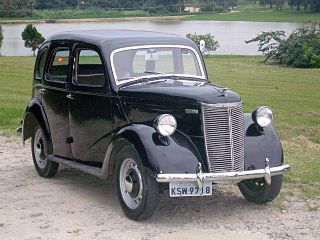
The Ford Prefect is a line of British cars which was produced by Ford UK between 1938 and 1961 as an upmarket version of the Ford Popular and Ford Anglia small family cars. It was introduced in October 1938 and remained in production until 1941. Returning to the market in 1945, it was offered until 1961. The car progressed in 1953 from its original perpendicular or "sit-up-and-beg" style to a more modern three-box structure. Some versions were also built and sold by Ford Australia.

Ford produced three cars between 1932 and 1934: the Model B, the Model 18, and the Model 46. These succeeded the Model A. The Model B had an updated four cylinder and was available from 1932 to 1934. The V8 was available in the Model 18 in 1932, and in the Model 46 in 1933 & 1934. The 18 was the first Ford fitted with the flathead V‑8. The company also replaced the Model AA truck with the Model BB, available with either the four- or eight-cylinder engine.
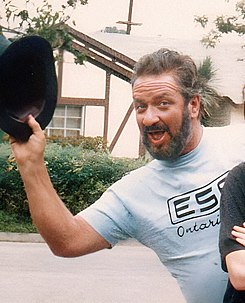
Ed "Big Daddy" Roth was an American artist, cartoonist, illustrator, pinstriper and custom car designer and builder who created the hot rod icon Rat Fink and other characters. Roth was a key figure in Southern California's Kustom Kulture and hot rod movement of the late 1950s and 1960s.

Kustom Kulture is a neologism used to describe the artworks, vehicles, hairstyles, and fashions of those who drove and built custom cars and motorcycles in the United States of America from the 1950s through today. It was born out of the hot rod culture of Southern California of the 1960s.

The modern definition of a rat rod is a custom car with a deliberately worn-down, unfinished appearance, typically lacking paint, showing rust, and made from cheap or cast-off parts. These parts can include non-automotive items that have been repurposed, such as using a rifle as a gear shifter, wrenches as door handles, and old saws as sun visors. A rat rod may or may not have extraneous decorations, but will always exude a great deal of personality due to the imagination required of the builder.
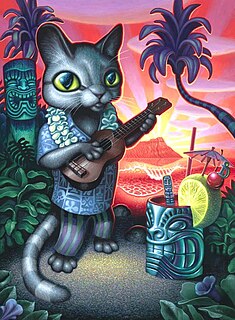
Lowbrow, or lowbrow art, describes an underground visual art movement that arose in the Los Angeles, California area in the late 1960s. It is a populist art movement with its cultural roots in underground comix, punk music, tiki culture, graffiti, and hot-rod cultures of the street. It is also often known by the name pop surrealism. Lowbrow art often has a sense of humor – sometimes the humor is gleeful, sometimes impish, and sometimes it is a sarcastic comment.
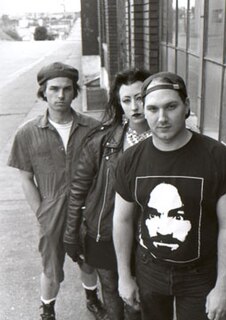
Kill Switch...Klick, also known as KsK and Kill Switch is the name of an American industrial rock band. The band is best known for its releases on Cleopatra Records and Go-Kustom Rekords. KsK was formed in 1991 by D.A. Sebasstian, a writer, film maker, musician and artist who had relocated from San Bernardino, California, to Seattle, Washington, late in 1989 where he currently resides.

The Fray is an American rock band from Denver, Colorado. Formed in 2002 by schoolmates Isaac Slade and Joe King, they achieved success with the release of their debut album, How to Save a Life in 2005, which was certified double platinum by the RIAA and platinum in Australia, Canada, New Zealand and the UK. The Fray achieved national success with their first single, "Over My Head ", which became a top ten hit in the United States. The release of their second single, "How to Save a Life", brought the band worldwide fame. The song charted in the top three of the Billboard Hot 100 and was a top 5 single in Australia, Canada, Ireland, Italy, Spain, Sweden, and the United Kingdom.
Coop is a hot rod artist working from Los Angeles. He was born in Tulsa, Oklahoma in 1968, and describes his occupation as "Insensitive Artiste." His work consists primarily of barely clothed or nude Bettie Page-style 1950s soft pornography and B-movie monsters, with the female characters often taking the role of "Devil-Women". The image most often associated with his work however is the face of a grinning devil with a smoking cigar clamped in its teeth.
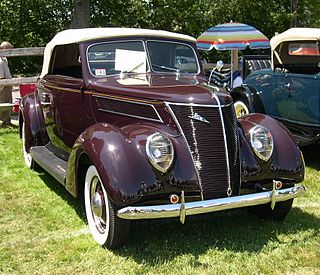
The Ford line of cars was updated in 1937 with one major change — the introduction of an entry-level 136 CID (2.2 L) V8 in addition to the popular 221 CID (3.6 L) flathead V8. The model was a refresh of its predecessor, the Model 48, and was the company's main product. It was redesigned more thoroughly in 1941. At the start of production, it cost $850. The Ford Line bore several model numbers during this period: For domestic 1937 production in the United States Ford Model Numbers for 85 hp V-8 equipped cars was Model 78 and 60 hp V-8 cars was Model 74. Models 81A and 82A in 1938, and Models 91A and 92A in 1939.

The Ford car was thoroughly updated in 1941, in preparation for a time of unpredictability surrounding World War II. The 1941 design would continue in an aborted 1942 model year and would be restarted in 1946 and produced until 1948 when the more modern 1949 Fords were ready. During the initial year of this car, it evolved considerably. The front fenders came in three pieces, the theory being that small damages could be replaced easily. During the year, it evolved into two pieces with the lower front and back sections being joined. The hood risers changed, the early ones being the same as 1940 Fords, changing during the year to the better later version. The 1941 Convertible had no rear side windows, the only side windows being in the doors; in 1942, quarter windows were added so the rear occupants could see out. Five different coil/distributor arrangements were used during 1941, causing confusion for mechanics. Other variations were: two different positions for the generator, and three for the cooling fan — front of the crankshaft, front of the generator (rare) and on a bracket. This is thought to be the first Ford to offer a replaceable cartridge oil filter as an option. The two interior heaters were a "Southwind" gasoline burner, which had the advantage of keeping one warm in winter at drive-in movies, and a more ordinary hot-water type. Both had window defrosters. It had an excellent radio, which could consume the battery in about two hours. Electric windshield wipers were available in addition to the vacuum-powered wipers. Three different convertible power top mechanisms and two different header bar latching systems were used. Rear suspensions sometimes had a sway bar, most did not. It had excellent brakes and among the best handling of ordinary cars of the time. It served a transitional role in Ford’s lineup.

Ford Motor Company introduced its De Luxe Ford line in 1938 as an upscale alternative to bridge the gap between its base model and luxury Lincoln offerings. The "Deluxe" name was used intermittently before and after this to specify an upscale trim, but the De Luxe Ford line was differentiated as a separate "marque within a marque" with separate styling and pricing through 1940. During 1939, Ford had five lines of cars: Ford, De Luxe Ford, Mercury, Lincoln-Zephyr, and Lincoln. After the war, this was simplified to Ford, Mercury, and Lincoln. The 1941 Ford line included "De Luxe" and "Super De Luxe" trim, but these vehicles were not marketed as a separate line. As Mercury sales progressed, the De Luxe approach was cancelled.
Ol' Skool Rodz is a bimonthly magazine published by Geno DiPol and Koolhouse Publications, featuring Kustom Culture lifestyles, Pin-Ups, Rat Rods, Kustom Cars, and Artwork. The magazine is based in New Jersey. It has a huge cult following and is considered an informative view of the Modern Kustom Culture lifestyle. Many of its articles are often written in a humorous style, often sending up the high-end car enthusiasts, legislators and even Kustom Kulture itself.
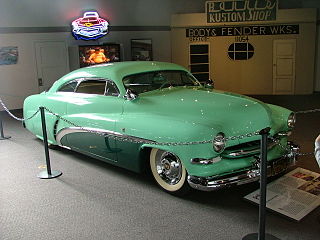
The Hirohata Merc is a 1950s custom car, often called "the most famous custom of the classic era". Setting a style and an attitude, it had a "momentous effect" on custom car builders, appeared in several magazines at the time and has reappeared numerous times since, earning an honorable mention on Rod & Custom's "Twenty Best of All Time" list in 1991. The impact may be measured by the fact that, after more than fifty years and numerous owners, it is still known as "the Hirohata Merc".

Source Interlink is an American magazine publishing and logistics company. It owns Source Interlink Distribution and Motor Trend Group. It maintains a strong position in automotive and action sports media, publishing a variety of magazines including Motor Trend, Hot Rod, and the Transworld titles.
Anthony Ausgang is an artist and writer born in Pointe-à-Pierre, Trinidad and Tobago in 1959 who lives and works in Los Angeles. Ausgang is a principal painter associated with the Lowbrow art movement, one of "the first major wave of lowbrow artists" to show in Los Angeles in the early 1980s. The protagonists of his paintings are cats -- "psychedelic, wide eyed, with a kind of evil look in their eyes".
Von Franco is a self-taught American artist associated with the Lowbrow art movement and Kustom Kulture. He became involved at an early age in the burgeoning hot rod and Kustom Kulture scene of Southern California. His skill at drawing hot rod and monster art, popular in Kustom Kulture, caught the attention of Ed "Big Daddy" Roth, for whom Von Franco later worked. Von Franco became a builder of custom automobiles, gaining notoriety for building clones of Norm Grabowski's Kookie, Kookie II and Lightning Bug t-buckets, as well as a clone/expansion of the Golden Rod. Von Franco is also known for his distinctive pinstriping and hand-lettering techniques. He was also the guitarist in the surf band The Bomboras and played the vibraphone in The Hyperions.
David Lozeau is an American artist and children's book writer who has achieved media recognition principally for his paintings and exhibits relating to the Day of the Dead. Based in San Diego, California, Lozeau is part of a modern art movement that depicts skeleton characters as if they were alive. His paintings also pay tribute to cars, motorcycles, and guitars which have led to collaborations with Harley-Davidson and Fender Guitar Company.

Michael "Blackie" Gejeian was an American race car driver, race car builder, and hot rod enthusiast. Considered an "Industry Legend", Gejeian was the organizer of the Autorama, one of the largest custom car shows in North America, held annually in Fresno, California.
Reginald Kalynn Campbell Jr, is an American artist, illustrator, cartoonist and writer/poet. He is best known for his work in the Lowbrow/Kustom Kulture movement, wherein he has been referred to as 'one of the most influential of the California Lowbrow artists'. As an illustrator, he created album/CD covers for notable bands like Megadeth, Reverend Horton Heat, and Social Distortion. His political cartoons were a fixture in Paul Krassner's 'The Realist' magazine from 1985 to 2001.
References
- 1 2 "OSR Bought out CK Deluxe". Jalopy Journal. Retrieved 29 November 2016.
- 1 2 "Car Kulture DeLuxe Magazine Honors Buck Owens with Interview about His Love of Music & Kool Cars; Buck Owens' Last Interview". BusinessWire. 30 March 2006. Retrieved 29 November 2016.